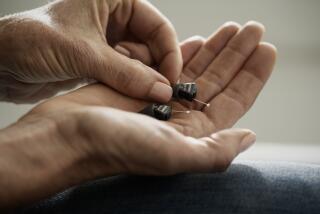When Selecting a Hearing Aid Get Facts--Don’t Play It by Ear
- Share via
Ever since the first hearing aid hit the market in the early 1800s (and was said to be worn by Beethoven), manufacturers have been trying to build a better device.
New models are smaller than ever. Some are pre-programmed to adjust automatically for different noise levels. But among consumers with hearing loss there is growing confusion.
How to choose the best device from a widening array of options? How much should you invest, since prices range from $500-$2,000 and are usually not covered by health insurance plans?
Regulations governing hearing aids will be stiffened within the next six months, FDA Commissioner David A. Kessler said at a Senate Special Committee on Aging hearing last month.
The Stats
One-third of Americans over 65 have hearing loss severe enough to affect their communication, says Donald Morgan, director of the Audiology Clinic at UCLA, citing government figures.
About 6.5 million Americans own hearing aid, according to Carole Rogin, president of the Hearing Industries Assn., a Virginia-based trade association of manufacturers.
Although hearing loss can happen at any time, most wearers have age-related loss, known as sensorineural disorder. A smaller number of people have abnormalities in the outer or middle ear. Their loss, called conductive, is usually treatable by surgery or drugs.
Do You Need Aid?
Experts disagree about exactly when to recommend a hearing aid. If you can hear sounds at an amplitude between 0 and 25 decibels over a range of frequencies, hearing is generally considered normal. (A low whisper is about 20 decibels, while normal conversation is about 60.) If hearing falls to 25 or 30 decibels, it is considered a mild hearing loss.
The Choices
Today, in-the-ear models are the most popular. The smallest of these are called in-the-canal and mini-canal aids. Larger behind-the-ear models are worn by fewer than 20% of users. Body aids, which include an ear mold and a power pack worn on the body, are used by only 1%, usually children.
The Concept
Whatever the size, hearing aids work on the same principle: Sound waves picked up with the help of the device’s tiny microphone are amplified and then conveyed to the ear with the help of a speaker. Hearing aids can greatly improve hearing but never return it to normal.
New Features
Some hearing aids now have automatic amplification. “These newer models amplify soft sounds more than loud sounds,” says Curt Williams, audiologist and spokesman for Oticon, a New Jersey-based hearing aid manufacturer.
Programmable hearing aids, another recent advancement, make it possible to set the device to amplify sounds differently in different environments, easing the transition between noisy environments and quieter ones.
In the Wings
Under development at the House Ear Clinic in Los Angeles is a type of hearing aid that could revolutionize the industry, says Sigfrid Soli, director of hearing aid research for the House Ear Institute. Right now the device is in prototype stage but Soli hopes it will be on the market by 1995.
Lifestyle Fittings
Which hearing aid is best for a person depends partly on the degree of hearing loss. But lifestyle also plays a role, UCLA’s Morgan says. The person fitting a hearing aid should ask the consumer to describe the environments encountered during a typical day: Noisy rooms or quiet offices? Background noises or not?
Finding a Specialist
Ear doctors often refer patients to a hearing aid fitter or to an audiologist. If your ear doctor does not, choose your own carefully, Morgan advises. Audiologists have an advanced degree in audiology and are trained to assess hearing loss. Audiologists may also be licensed as dispensers. Dispensers are licensed to fit and test aids.
Find someone who has been in business awhile, advises Williams of Oticon. “And go to someone who deals with many lines, not just one,” he adds.
Consumer Caveats
Most hearing aids are sold on a trial basis, usually 30 days but sometimes longer. “Be sure you understand the return policy,” says Soli.
The typical life of a hearing aid is about three to five years, manufacturers say.





